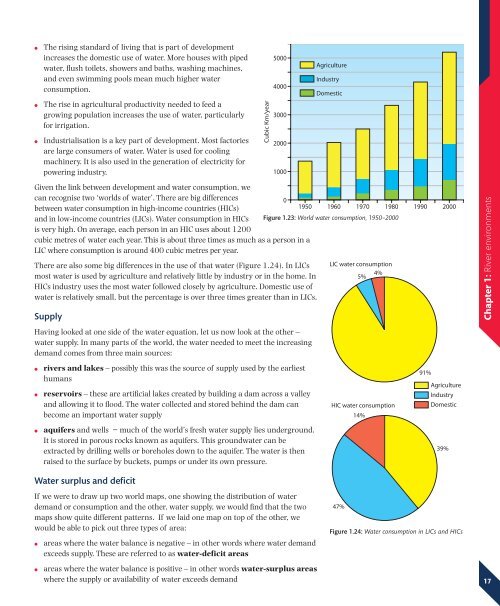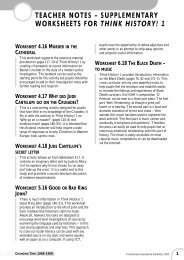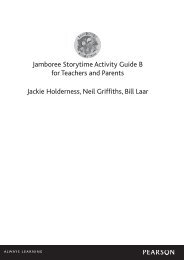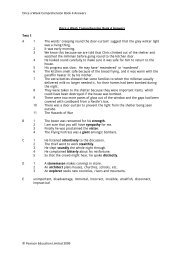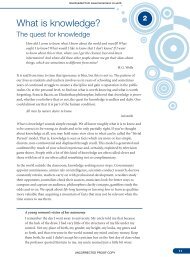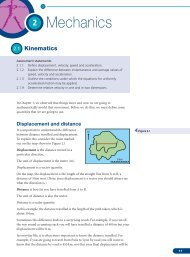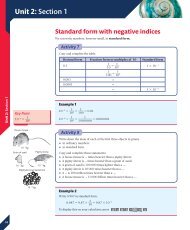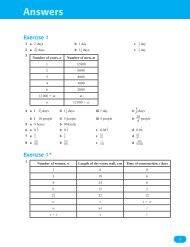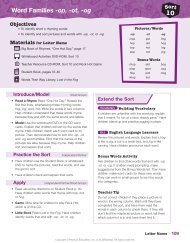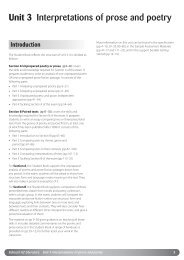Edexcel IGCSE Geography Chapter 1 - Pearson Schools
Edexcel IGCSE Geography Chapter 1 - Pearson Schools
Edexcel IGCSE Geography Chapter 1 - Pearson Schools
Create successful ePaper yourself
Turn your PDF publications into a flip-book with our unique Google optimized e-Paper software.
●●●The rising standard of living that is part of developmentincreases the domestic use of water. More houses with pipedwater, flush toilets, showers and baths, washing machines,and even swimming pools mean much higher waterconsumption.The rise in agricultural productivity needed to feed agrowing population increases the use of water, particularlyfor irrigation.Industrialisation is a key part of development. Most factoriesare large consumers of water. Water is used for coolingmachinery. It is also used in the generation of electricity forpowering industry.Given the link between development and water consumption, wecan recognise two ‘worlds of water’. There are big differencesbetween water consumption in high-income countries (HICs)01950 1960 1970 1980 1990 2000and in low-income countries (LICs). Water consumption in HICs Figure 1.23: World water consumption, 1950−2000is very high. On average, each person in an HIC uses about 1200cubic metres of water each year. This is about three times as much as a person in aLIC where consumption is around 400 cubic metres per year.There are also some big differences in the use of that water (Figure 1.24). In LICsmost water is used by agriculture and relatively little by industry or in the home. InHICs industry uses the most water followed closely by agriculture. Domestic use ofwater is relatively small, but the percentage is over three times greater than in LICs.SupplyHaving looked at one side of the water equation, let us now look at the other –water supply. In many parts of the world, the water needed to meet the increasingdemand comes from three main sources:●●●rivers and lakes – possibly this was the source of supply used by the earliesthumansreservoirs – these are artificial lakes created by building a dam across a valleyand allowing it to flood. The water collected and stored behind the dam canbecome an important water supplyaquifers and wells − much of the world’s fresh water supply lies underground.It is stored in porous rocks known as aquifers. This groundwater can beextracted by drilling wells or boreholes down to the aquifer. The water is thenraised to the surface by buckets, pumps or under its own pressure.Cubic Km/year50004000300020001000AgricultureIndustryDomesticLIC water consumption4%5%HIC water consumption14%91%AgricultureIndustryDomestic39%<strong>Chapter</strong> 1: River environmentsWater surplus and deficitIf we were to draw up two world maps, one showing the distribution of waterdemand or consumption and the other, water supply, we would find that the twomaps show quite different patterns. If we laid one map on top of the other, wewould be able to pick out three types of area:●●areas where the water balance is negative – in other words where water demandexceeds supply. These are referred to as water-deficit areasareas where the water balance is positive – in other words water-surplus areaswhere the supply or availability of water exceeds demand47%Figure 1.24: Water consumption in LICs and HICs17


